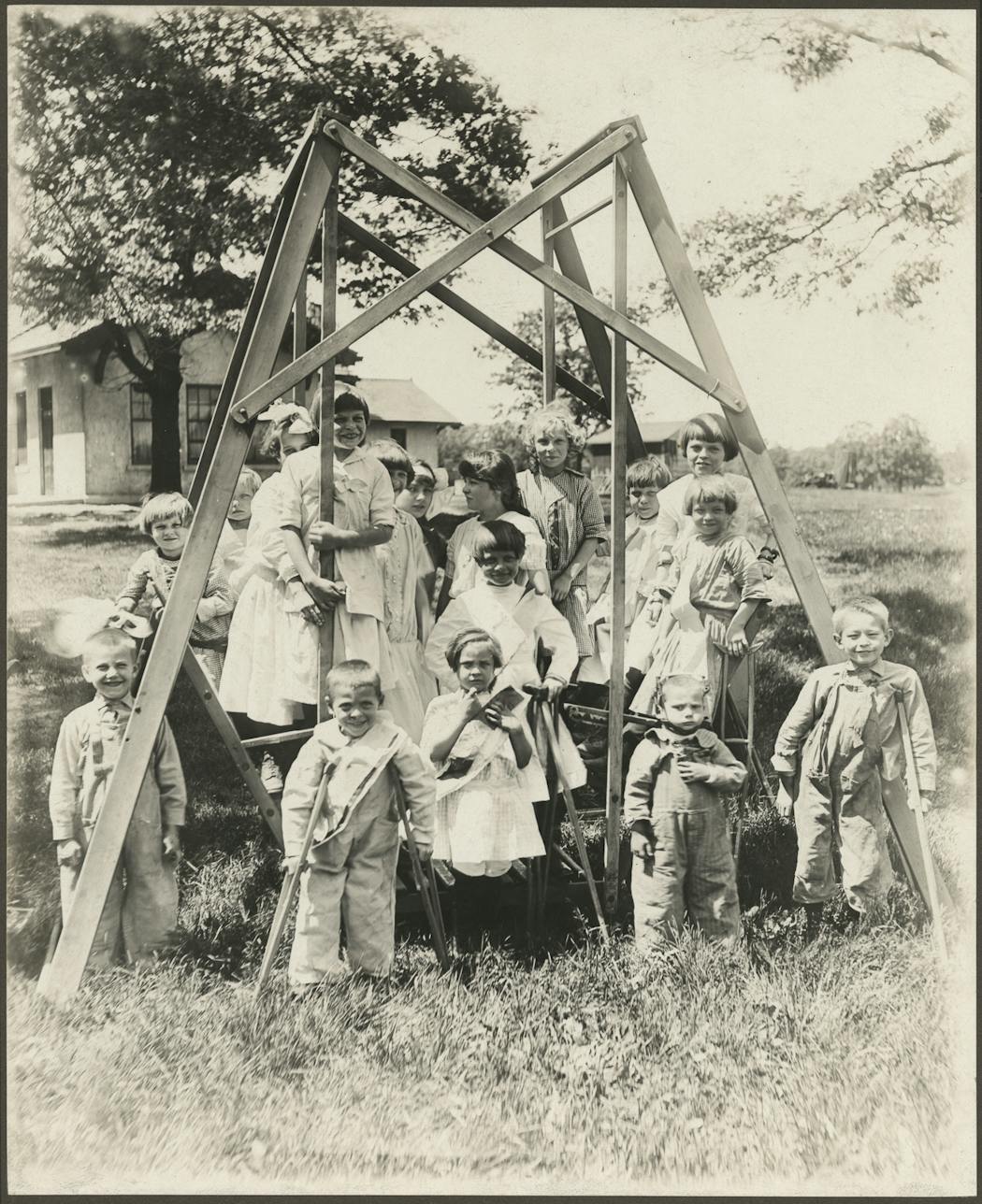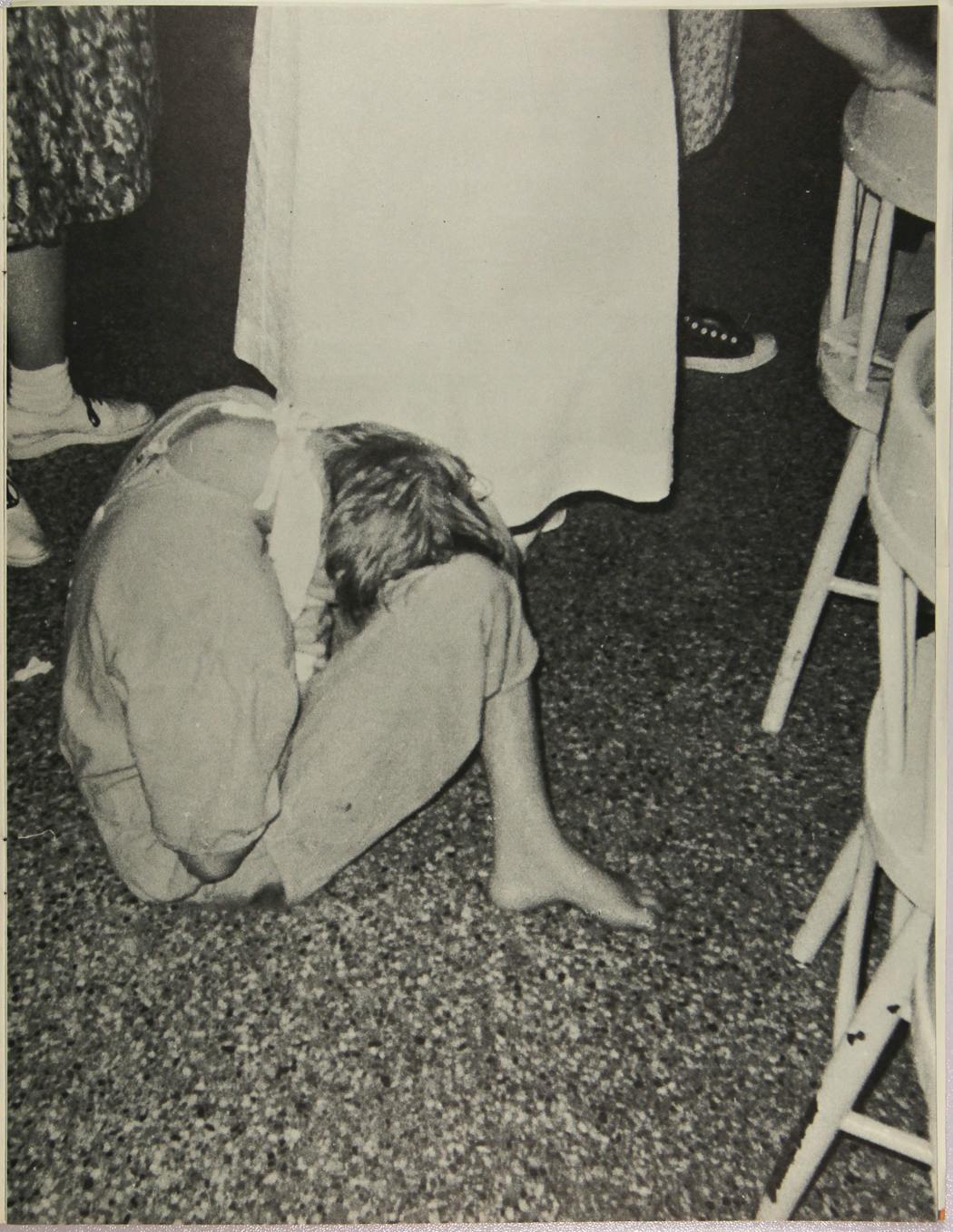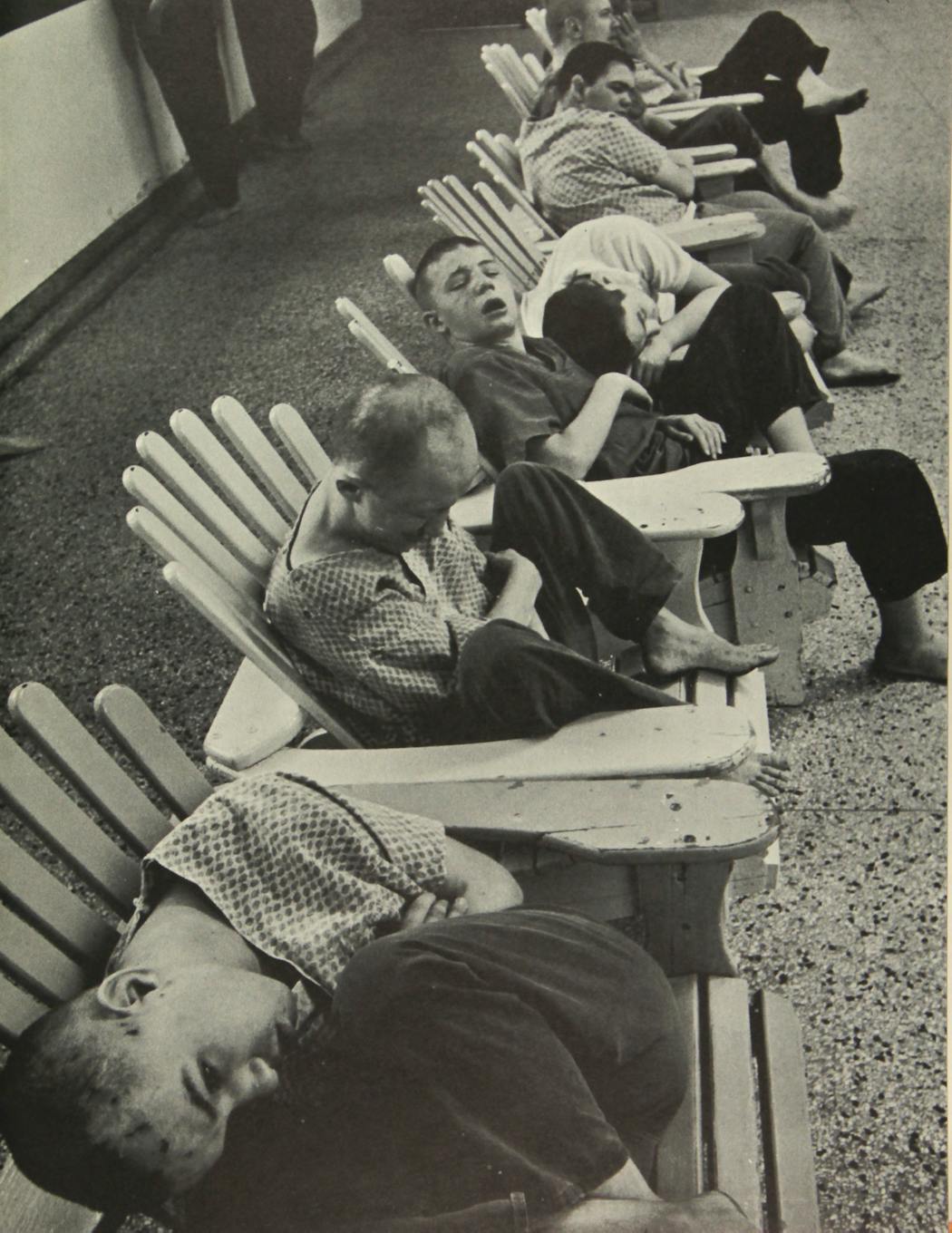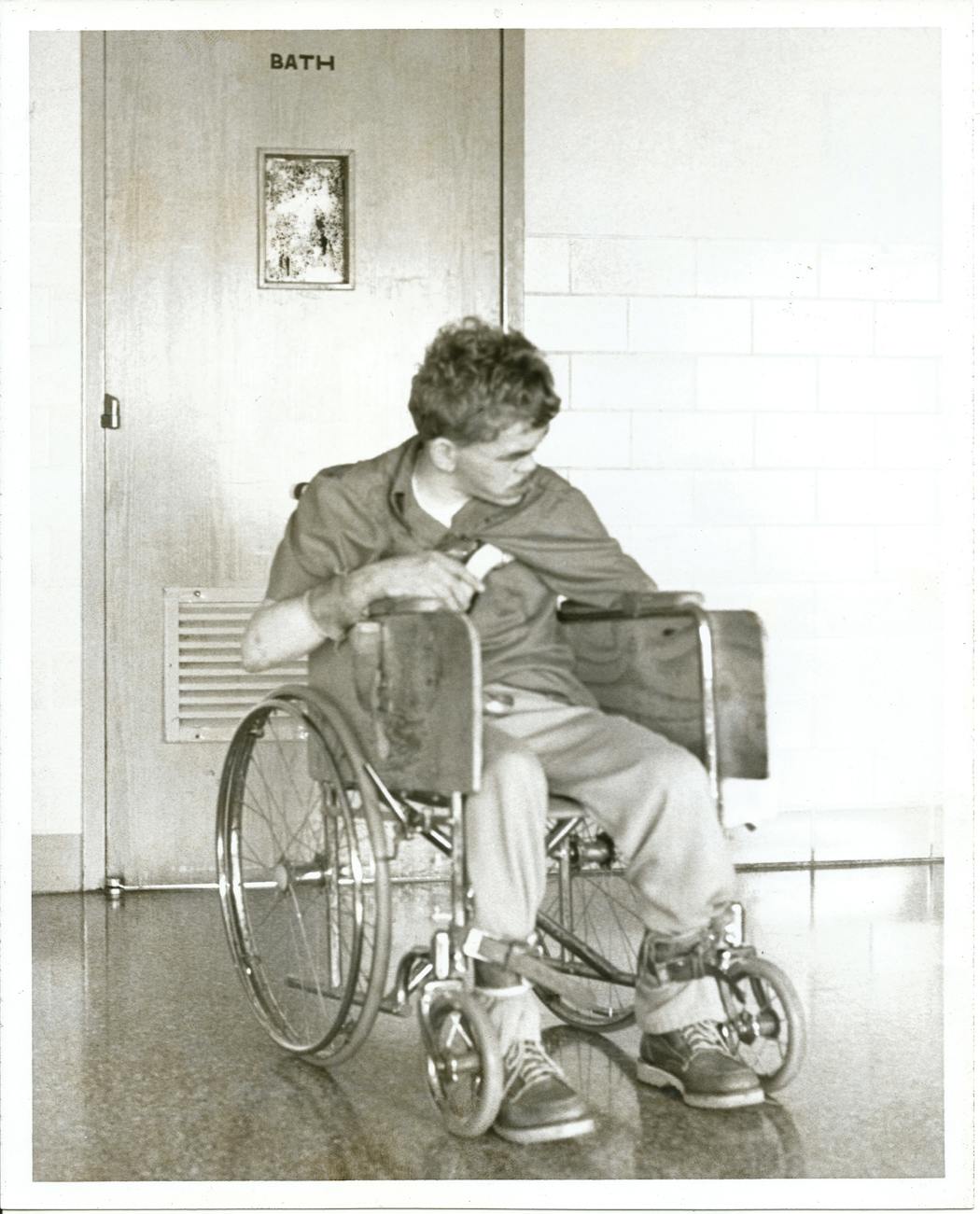Some of the photos are shocking. A girl scrunching up on the floor of a room where, according to the caption, she's been kept in isolation for months. A row of boys slouching in Adirondack chairs with nothing to do. A boy bound by his wrists and ankles in a wheelchair; he's also been restrained in bed at night, according to the caption, and hadn't spent more than 10 consecutive minutes outside of restraints.
The photos are of Minnesotans confined in institutions, a common practice throughout the 20th century for people with intellectual and developmental disabilities. Many went into the facilities as children and spent their whole lives there.
The photos are part of "Include/Exclude," a traveling exhibit created by the Minnesota Governor's Council on Developmental Disabilities that opened this month in connection with National Disability Employment Awareness Month. The images and text in the exhibit's roughly chronological display panels start out grim, but gradually become more upbeat as they move into more recent years.
Although there still are problems with the system, a recent survey indicates that Minnesota employers are more open to hiring and accommodating people with developmental disabilities. And a new state law offers reimbursement and support to companies that hire disabled employees.
"Include/Exclude" has been on view this week at the U.S. Bancorp building in downtown Minneapolis and will continue next week at U.S. Bank Plaza, also in Minneapolis. In coming weeks it will be displayed at various other corporate headquarters — including Cargill, U.S. Bank, 3M and Medtronic — as well as at the St. Paul Equity Summit on Nov. 14.
The Governor's Council organized the exhibit with the goal of spreading awareness of a little-known history, said Colleen Wieck, the council's executive director.
"It's another way to bring out the information, because we don't teach disability history or disability rights in school," Wieck said.
Parents of children labeled "feeble-minded" were once routinely told to "go home, have another child, place this child [in an institution], forget about this child," Wieck said. "That was the medical advice."
Minnesota once had three state institutions specifically built for people with developmental disabilities — Faribault, Cambridge and Brainerd State Hospitals, later called regional treatment centers — along with units within five other facilities.
It's not ancient history. The last Minnesotan left an institution as recently as 2000, Wieck said. And 33 other states continue to institutionalize kids, with about 16,000 currently living in large public facilities.
Just last year, Iowa set new rules after an investigation by the U.S. Department of Justice found that people with severe disabilities in a facility in Glenwood, Iowa, were being subjected to medical experiments without their consent.
During the Depression and World War II, residents often were forced to work on farms, growing their own food — involuntary servants paid $1 a month, Wieck said.
After years of this routine institutionalization, Minnesota parents began in the 1960s seeking education and vocational training for their kids and working with the media to expose poor living conditions in institutions.
In the 1970s and 1980s, courts found that institutionalization, restraint and seclusion violated residents' constitutional rights and that people with intellectual disabilities have a right to treatment in the least-restrictive environment.
In 1987, Minnesota's Partners in Policymaking program was created to educate and train self-advocates and parents to work for change. People with developmental disabilities began speaking out themselves, the exhibit says, and "challenging systems that did not recognize their right to make their own decisions about what they wanted to do and where and with whom they wanted to live."
Progress continued, and a court ruling in 2020 opened the way to more rights and protections for people with disabilities.
Creating opportunities
Meanwhile, the state has been working to promote employment opportunities for people with disabilities.
In April of this year, a survey sponsored by the Governor's Council, "Enhancing Employment Opportunities for People With Disabilities" found that two-thirds of companies at locations with five or more employees have employees with disabilities. Reasons employers cited included a desire for the workforce to reflect its community and worker shortages exacerbated by the pandemic.
The survey also found that employers are equally satisfied with their employees with disabilities as they are with those without. Just over half of employers have needed to provide accommodations for their employees with disabilities, and half of those accommodations cost less than $1,000 per employee.
There's good news on that front, too. This year the Legislature took a step to make it easier for small businesses to hire people with disabilities, approving the Employer Reasonable Accommodation Fund.
Launched Sept. 1 and administered by the Department of Employment and Economic Development (DEED), the fund allows reimbursement for small- to midsized businesses for costs involved with providing accommodations for job applicants and employees with disabilities. Accommodations could include such things as wheelchair ramps, sign-language interpreters, transcription of materials into Braille or audio format and other equipment and services.
Reimbursements can go up to $15,000 for one-time accommodations, such as installing a wheelchair ramp, and up to $30,000 per year for ongoing expenses, like an interpreter.
"We believe, though again this is early, most accommodations are not that expensive," said Natasha Jerde, director of DEED's State Services for the Blind. "Most are less than even $500. You may laugh a little bit but they can be things like duct tape," used to modify an employee's workstation for better accessibility.
DEED also offers free consultation and technical assistance and can connect companies looking for employees with people looking for jobs, she said.
There's still room for improvement. Unemployment among people with disabilities (about 10% in Minnesota, 13% nationally) is more than double that of people without disabilities (about 4% in Minnesota, 6% nationally). Employment is critical for improving the lives of people with developmental disabilities, Wieck said.
"We're still working to get even more people employed, still working on them having lives of their choosing, not somebody else choosing for them," she said. "It can't be someone on the outside telling them they have to do it."
Singing, ceremonies and straw hats: Olympics opening ceremony in Tahiti centers Polynesian culture

Three 101-year-old friends recall fond memories in 1940s Alexandria
Celine Dion makes musical comeback at Paris Olympics with Eiffel Tower serenade







